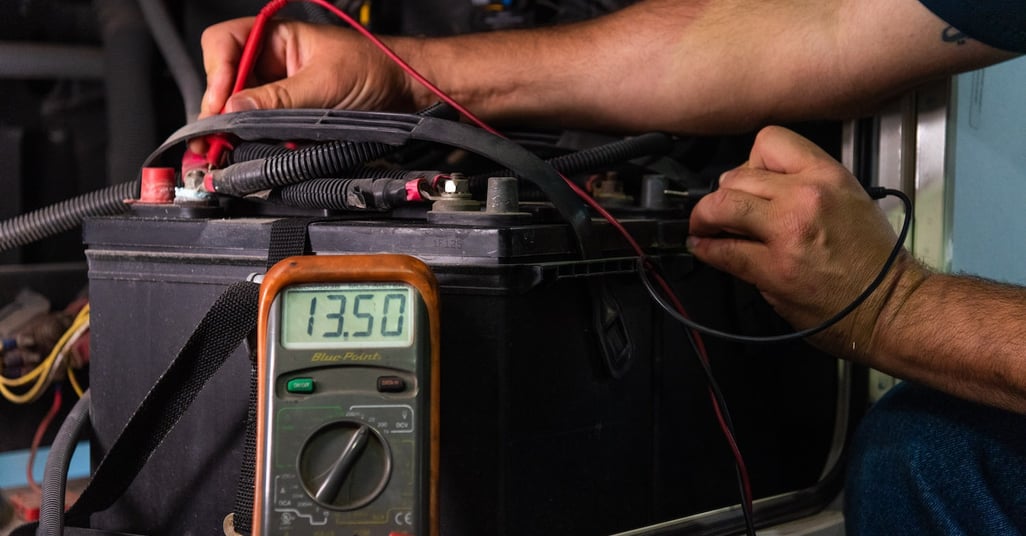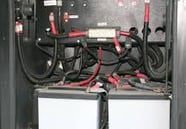The Importance of Battery Maintenance: Why Regular Checks Are Essential
Battery maintenance is a crucial aspect of RV ownership that often gets overlooked. Regular checks ensure that your battery remains in optimal condition, providing reliable power for all your electrical needs while on the road. Neglecting this task can lead to diminished performance, unexpected breakdowns, and costly replacements.
On-The-Go Mobile RV Repair
11/21/20245 min read


Understanding Battery Basics
Batteries are essential components that power a wide range of devices, from automobiles to personal electronics. At their core, batteries store and release electrical energy through chemical reactions. The primary types of batteries commonly in use include alkaline, lithium-ion, lead-acid, and nickel-metal hydride, each serving specific needs and applications. Alkaline batteries are often found in household gadgets like remote controls and toys, while lithium-ion batteries are the preferred choice for smartphones and laptops due to their efficiency and high energy density. Lead-acid batteries, prevalent in vehicles, provide a robust solution for starting engines and powering electrical systems.
By routinely inspecting your battery for corrosion, checking fluid levels, and testing its charge, you can prevent problems before they happen. Proper maintenance not only extends the lifespan of your battery but also enhances the overall safety and functionality of your battery, allowing you to enjoy your adventures without the worry of being stranded. Whether you’re planning a weekend getaway or a cross-country trip, keeping your battery in check is smart for a smooth and hassle-free journey.
The fundamental operations of a battery revolve around two key components: the anode and cathode, which are both immersed in an electrolyte. The anode, typically made from materials like zinc or lithium, undergoes an oxidation reaction by releasing electrons during the discharge process. Meanwhile, the cathode, often composed of metal oxides, attracts these electrons to complete the circuit. The electrolyte facilitates the flow of ions between the two electrodes, creating a pathway for the chemical reactions that produce electricity. This interplay between electrodes and electrolytes is crucial for the battery's performance, affecting its capacity, voltage, and overall lifespan.
Understanding these battery fundamentals is vital, as it underscores the importance of regular maintenance checks. Well-maintained batteries not only ensure optimal performance but also extend their lifespan, which is increasingly important in today's device-dependent world. Different battery types may require specific maintenance practices; for instance, lead-acid batteries benefit from periodic checks for corrosion and fluid levels, while lithium-ion batteries may need monitoring for charge cycles. Comprehensive knowledge of how batteries work paves the way for effective maintenance strategies, enhancing safety and efficiency in everyday applications.
Signs of Battery Wear and Tear
Batteries, regardless of their type, naturally degrade over time, and it is crucial for users to recognize the signs of wear and tear to ensure optimal performance and longevity. One of the most common indicators of battery deterioration is decreased performance. Users may notice that devices powered by the battery are not functioning as efficiently as before. This can manifest as a reduced runtime or a longer time needed for the battery to recharge, signaling that its capacity is diminishing.
Physical swelling is another alarming sign of battery distress. When a battery begins to swell, it can create pressure on the casing, potentially leading to leaks or even rupture. This issue is often seen in lithium-ion batteries and should be addressed immediately to prevent potential hazards.
Corrosion on battery terminals is also a critical sign that maintenance is required. This corrosion, which appears as a white or green powdery substance, can hinder the electrical connection between the battery and the device, leading to erratic performance or complete failure. Regular cleaning of terminals can prevent further damage and prolong the battery's lifespan.
Lastly, an increasingly rapid discharging of the battery is a clear indication that it may be nearing the end of its lifecycle. If a battery discharges significantly faster than it used to, this suggests a reduction in its ability to hold a charge. Monitoring charge cycles and frequency of use can help in identifying this issue early on.
Recognizing these signs promptly is paramount in maintaining battery efficiency and avoiding unforeseen failures. By staying vigilant, users can take proactive measures to address issues, ultimately contributing to better performance and safety for their devices.
Benefits of Regular Battery Maintenance
Regular battery maintenance is essential to ensure optimal performance and longevity of batteries used in everyday devices. One of the primary benefits of conducting routine checks is the significant extension of a battery's lifespan. By identifying issues early and addressing them promptly, users can avoid premature battery failure, thereby prolonging the time before a replacement is necessary.
In addition to extending lifespan, regular maintenance can enhance the performance of devices powered by these batteries. A well-maintained battery operates efficiently, delivering consistent power output which, in turn, improves the overall functionality of devices. This is particularly crucial for high-demand devices such as smartphones, laptops, and electric vehicles, where reliable performance is paramount.
A crucial economic advantage of regular battery maintenance is the potential for cost savings on replacements. Batteries can be costly, and frequent replacements can quickly add up. By investing time in maintaining batteries, users can reduce the frequency of replacements, thereby conserving financial resources in the long run.
Safety is another critical benefit associated with regular checks. Batteries, particularly those that are rechargeable or used in high-capacity applications, can pose risks if not properly maintained. Routine inspections help to minimize the risk of issues such as leaks, overheating, or even explosions. By ensuring that batteries are in optimal condition, users can significantly reduce these safety hazards.
Lastly, the environmental impact of extending a battery’s life cannot be overlooked. By minimizing the need for replacements, users contribute to a reduction in electronic waste. Batteries contain hazardous materials that can harm the environment if not disposed of properly. Therefore, regular maintenance not only benefits battery performance and safety but also represents a responsible choice for the environment, promoting sustainable practices in our daily lives.
Best Practices for Battery Maintenance
Maintaining batteries effectively requires adherence to several best practices. Proper storage conditions play a crucial role in preserving battery life. Batteries should be stored in a cool, dry place away from direct sunlight and heat sources, as extreme temperatures can negatively affect performance. For lead-acid car batteries, it's essential to keep them adequately charged, particularly during prolonged periods of inactivity. A fully charged battery can withstand environmental stressors better than a discharged one, thus prolonging its lifespan.
Regular cleaning of battery terminals is another vital practice. Corrosion can build up on the terminals over time, creating resistance that may hinder performance. Using a mixture of baking soda and water can effectively clean battery terminals, restoring good contact. Additionally, it's essential to check for any signs of damage, such as cracks or leaks, as this can indicate a failing battery that needs to be replaced. Ensuring proper contact through cleaning and inspecting contributes significantly to overall battery efficiency.
Charging habits also warrant attention. For rechargeable lithium-ion batteries, which are commonly used in smartphones and laptops, maintaining a charge between 20% and 80% is ideal. This practice helps reduce stress on the battery, enhancing its longevity. Furthermore, regularly monitoring the temperature of batteries is essential, especially in automobiles where extreme heat can be detrimental. Batteries should ideally operate between 20°C to 25°C (68°F to 77°F) to maintain optimal functionality.
As a general guideline, checking automotive batteries at least once a month ensures that they are in good condition. For rechargeable batteries, a similar frequency can be maintained, verifying both performance and physical condition. Following these best practices will foster a proactive approach to battery maintenance, ultimately saving time and costs associated with premature battery failure.


"My RV's battery looks so ugly and nasty, I half expect it to start charging me rent for the space it’s taking up!"


"Regular battery maintenance: because if I wanted to deal with drama, I’d just binge-watch a soap opera instead!"


"Basic battery maintenance: the only time I willingly get my hands dirty just to avoid a shocking surprise later!"

